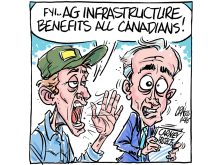ON A grey, November afternoon last week, three faces of the enduring dilemma of hunger, malnutrition and starvation in a food-rich world were on display …
In Ottawa, prime minister Jean ChrŽtien was pleading with the world to mobilize a relief effort to save a million lives in Zaire. Canada would lead it, if asked.
In Rome, agriculture minister Ralph Goodale headed a delegation of Canadian politicians, bureaucrats and development workers at the second World Food Conference in 22 years. The conference this week will endorse the goal of “food for all”.
Read Also

Downturn in grain farm economics threatens to be long term
We might look back at this fall as the turning point in grain farm economics — the point where making money became really difficult.
The latest looming disaster of starvation and disease in a part of Africa riven by war and ethnic hatred was a sombre backdrop to millions of words and tonnes of paper that would be dispensed in Rome to promote the “right” to food security.
Yet on the telephone that day came a description of the third face, the face that shows the gap between the rhetoric of ending hunger and the reality of little action.
Gerry Trant, former senior Agriculture Canada bureaucrat and a veteran of the 1974 World Food Conference, cautioned that now, as then, there will be a gap between what the world says it wants to do, and what it does, or is capable of doing.
The first conference ended with the declaration that within a decade, by 1984, no child should go hungry.
Political will, scientific advances and an emphasis on agriculture would solve the problem. A World Food Council of ministers was created to direct the international war on hunger.
“There was some feeling of optimism,” recalls Trant, who went on to serve for six years as executive-director of the Rome-based World Food Council, beginning in 1986. “People were scared. There was a feeling at last there would be some movement.”
But reality soon took over.
There was in-fighting at the United Nations over the authority the new council should have. Political support from member countries often flagged.
The promise of India’s green revolution came to earth as policy makers more clearly understood that hunger usually flows from poverty, rather than lack of food.
And as the ideology of market economics took hold, governments in the developed world were less inclined to use the state to try to solve problems.
“There has been a real faltering of enthusiasm and support for government-aided development,” said Trant.
Instead, the World Bank, with its campaign against socialism, social programs and subsidies, set the agenda with its demand that only countries adopting open market policies will qualify for help.
“Its philosophy is ‘structural adjustment and screw the poor’,” said Trant.
The result has been the continuing blight of knowing more than 800 million humans exist without enough to eat.
The commitments of the Rome Declaration 1996 are unlikely to put food on their tables.
“It is good to highlight the issue again,” said Trant, now living near Ottawa. “But hunger and poverty go hand in hand. Where there is poverty, there is hunger.”
















